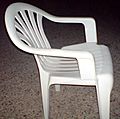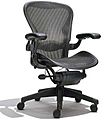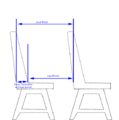Chair facts for kids
A chair is a common piece of furniture used for sitting. It usually has a seat, a back, and often armrests. Most chairs are made for one person. They typically have four legs to lift the seat off the floor. Even if the legs are very short, it's still a chair!
If a seat doesn't have a back or armrests, it's called a stool. For more than one person, a seat might be called a couch, sofa, settee, loveseat, or bench. A separate rest for your feet is known as an ottoman or pouffe. When a chair is fixed in a vehicle or a theater, it's usually just called a seat. Most chairs you find in homes can be moved around easily.
The back of a chair often doesn't go all the way down to the seat. This helps air flow and keeps you cool. Sometimes, the back or seat might have holes or be made of materials that let air through. This is for both decoration and comfort.
Some chairs have backs that go above your head. These might even have separate headrests. Headrests in cars are very important. They help protect your neck from injuries like "whiplash" if the car stops suddenly or is hit from behind.
Chair Design

When chairs are designed, many things are considered. Designers think about how the chair will be used. They also think about how comfortable it will be for the person sitting in it. This is called ergonomics. Other important things include the chair's size, if it can be stacked or folded, its weight, and how long it will last. Designers also consider if it resists stains and how it looks artistically.
The way a chair is used helps decide how you should sit in it. For example, "task chairs" are for working at a desk or table. These chairs can only lean back a little. If they leaned back too much, you would be too far from your work. Chairs for dentists, however, need to lean back a lot. Chairs for watching TV might lean back a bit, depending on the screen's height.
Comfort and Support
Good chair design helps spread your body's weight evenly. If a seat is too high, your feet might dangle. This puts more pressure on the back of your knees. It can also mean your feet don't support any weight, so other parts of your body take more strain. If a seat is too low, too much weight might press on your "seat bones."
When a chair's seat and back lean back, some of your weight shifts to your back. This can make the seat area more comfortable for some people. However, it might not be good for others who have back problems. Generally, if you plan to sit for a long time, some weight should be taken off the seat. That's why "easy chairs" for long sitting periods usually lean back a little. But leaning back isn't good for chairs used for working or eating at a table.
The back of a chair helps support your body weight. This reduces the pressure on other parts of your body. Chair backs come in different heights:
- Lower backrests support only your lower back.
- Shoulder height backrests support your whole back and shoulders.
- Headrests support your head too. As mentioned, these are vital in cars to prevent neck injuries.
Reclining chairs usually have backrests that reach at least shoulder height. This helps shift weight to your shoulders instead of just your lower back.
Some chairs also have footrests. A stool or a simple chair might have a bar near the bottom. You can place your feet on this bar for extra comfort.
Images for kids
-
Chair, circa 1772, mahogany, covered in modern red morocco leather, height: 97.2 cm, Metropolitan Museum of Art (New York City)
-
The Coronation Chair, circa 1300
-
The Monobloc chair is a lightweight stackable polypropylene chair, usually white in colour, often described as the world's most common plastic chair.
-
Metal chairs in the Tuileries Garden, Paris, France
-
The type of chair popular in western Hubei, China: with a fairly low seat and the back inclined at about 45 degrees from the vertical
-
Highly decorated carved-back chairs in Mexico
-
Eames Lounge chair and ottoman
-
Prifardd (Poet) Robin Owain in the bardic chair, 1991
See also
 In Spanish: Silla para niños
In Spanish: Silla para niños

















